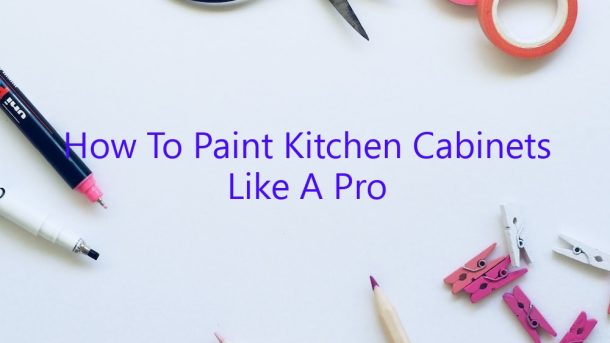If you’re looking to give your kitchen cabinets a fresh new look, painting them may be the way to go. Painting cabinets can be a relatively easy DIY project, but it can also be tricky to get the results you want. If you’re not confident in your painting skills, or you don’t have the time to do it yourself, you may want to hire a professional.
But if you’re determined to tackle the project yourself, here are a few tips to help you get started:
1. Remove all of the cabinet hardware, including the knobs, pulls, and hinges. This can be a tedious task, but it’s important to do it properly so that the paint will adhere to the surfaces.
2. Sand the surfaces of the cabinets thoroughly. This will help the paint to adhere and will also give the cabinets a nice smooth finish.
3. Choose the right type of paint. There are a variety of paints available, from latex to oil-based paints, so be sure to choose one that is appropriate for the surface you are painting.
4. Prime the surfaces of the cabinets with a primer that is appropriate for the type of paint you are using. This is especially important if the cabinets are made from a porous material, such as wood.
5. Apply the paint in thin coats, allowing each coat to dry completely before applying the next. This will help to avoid any drips or streaks.
6. Reattach the cabinet hardware once the paint has dried completely.
If you follow these tips, you should be able to achieve beautiful results that will improve the look of your kitchen cabinets.
Contents
What do professionals use to paint kitchen cabinets?
When it comes to painting kitchen cabinets, there are a few different options that professionals can use. In this article, we will take a look at the three most common methods: spraying, rolling, and brushing.
Spraying is the most popular method, as it is the quickest and most efficient way to paint cabinets. It is also the most expensive, as it requires the use of specialized equipment. However, it produces a very even finish and is less likely to cause any drips or streaks.
Rolling is the next most popular method, and it is a little less expensive than spraying. It is a slower process than spraying, but it is still relatively quick and produces a very even finish.
Brushing is the cheapest and slowest method, but it can be used to achieve a very high quality finish. It is also the most difficult method, as it requires a lot of skill and patience.
How do you get the smoothest finish when painting cabinets?
Painting cabinets can be a great way to update the look of your kitchen on a budget. However, getting a smooth finish can be a challenge. Here are a few tips to help you get the best results.
1. Choose the right paint. Not all paints are created equal. When choosing a paint for your cabinets, opt for a high-quality latex paint. Latex paints tend to be less glossy and more durable than oil-based paints.
2. Sand the cabinets thoroughly. Before painting, it’s important to sand the cabinets thoroughly. This will help to ensure a smooth finish. Be sure to sand in the direction of the wood grain.
3. Prime the cabinets. If the cabinets are stained or if there is any existing paint on them, it’s important to prime them before painting. This will help to ensure a smooth finish and will also help the paint to last longer.
4. Choose the right paint brush. When painting cabinets, it’s important to use a brush that will give you a smooth finish. Choose a brush with synthetic bristles, as these bristles are less likely to leave streaks.
5. Paint in small sections. When painting cabinets, it’s best to paint in small sections. This will help to ensure a smooth finish.
6. Use a wet brush. When painting the final coat of paint, use a wet brush. This will help to create a smooth, glossy finish.
7. Let the paint dry completely. It’s important to let the paint dry completely before putting anything back in the cabinet. This will help to ensure a durable finish.
Is it better to spray or brush paint kitchen cabinets?
When it comes to painting your kitchen cabinets, there are two main ways to do it: spraying or brushing. Both have their own benefits and drawbacks, so it can be tough to decide which one is right for you. In this article, we will take a look at the pros and cons of both methods so that you can make an informed decision.
Spraying kitchen cabinets is the more popular option, as it is a quick and efficient way to get the job done. All you need is a good quality spray gun and some paint, and you can have your cabinets looking new in no time. The main benefit of spraying is that it results in a very even finish, with no drips or streaks. It is also a lot faster than brushing, so if you are short on time, spraying is the way to go.
However, spraying does have a few drawbacks. First of all, it can be a bit tricky to get the hang of, and it takes a bit of practice to get the results you want. It is also more expensive than brushing, as you need to buy a good quality spray gun. Finally, spraying can be a bit messy, so you will need to take precautions to avoid getting paint all over your kitchen.
Brushing kitchen cabinets is the traditional way to paint them, and it has a few advantages over spraying. Firstly, it is a lot cheaper than spraying, as you only need a brush and some paint. It is also a lot easier to control, so you can achieve a more precise finish. Finally, brushing is a lot less messy than spraying, so if you are worried about making a mess, this is the option for you.
However, brushing does have a few drawbacks. It is a lot slower than spraying, so it will take longer to finish the job. It is also more difficult to get an even finish, so you may have to do a few coats to achieve the look you want. Finally, brushing can be a bit tricky if you are not used to it, so it may take a bit of practice to get the hang of it.
So, which is the best option for you? If you are short on time and want a quick and easy way to paint your cabinets, spraying is the way to go. If you want a more precise finish, or are on a budget, brushing is the better option.
How can I paint my kitchen cabinets without brush marks?
If you’re looking to paint your kitchen cabinets without any brush marks, you’re in luck. By taking a few precautions, you can ensure that your cabinets turn out looking great.
The first step is to make sure that your cabinets are thoroughly clean and free of any dirt or grease. If they’re not, you’ll need to clean them before you start painting. You can use a degreaser or a general-purpose cleaner to do this.
Once your cabinets are clean, it’s time to start painting. You’ll want to use a high-quality paint, such as an acrylic latex paint. Apply a thin coat of paint to the cabinet with a brush, making sure to avoid any brush marks. If you need to apply a second coat, make sure that the first coat is completely dry before you start.
If you’re using a spray paint, make sure to shake the can well before you start spraying. Hold the can about 18 inches away from the cabinet and spray in short, even strokes. Again, make sure to avoid any brush marks.
Once the paint is dry, you can apply a clear coat of finish if desired. This will protect the paint and help to keep it looking fresh for years to come.
What brand of paint is best for kitchen cabinets?
When it comes to painting your kitchen cabinets, there are a lot of options to choose from. You can go with a standard latex paint, an oil-based paint, a specialty paint, or a stain. So, what’s the best option for your kitchen?
Latex paint is a good choice for kitchen cabinets because it’s durable, easy to clean, and comes in a variety of colors. It’s also affordable, which is a plus. However, latex paint can sometimes be tricky to work with, so if you’re not experienced with painting, it might be a good idea to go with a different type of paint.
Oil-based paint is a good option for cabinets that need to be covered in a high-quality finish. It’s also a good choice for cabinets that are in a high-traffic area, such as the kitchen, because it’s durable and resistant to wear and tear. However, oil-based paint can be difficult to work with and it’s not as environmentally friendly as latex paint.
Specialty paints, such as chalk paint and milk paint, are a good option for cabinets that need a unique look. They’re also a good option for cabinets that are in bad condition, because they can cover up a lot of flaws. However, specialty paints can be expensive and they can be difficult to find.
Stains are a good option for cabinets that are already made out of a beautiful wood. They show the natural beauty of the wood and they come in a variety of colors. However, stains can be difficult to apply and they often require a lot of maintenance.
So, what’s the best option for your kitchen cabinets? It depends on your needs and preferences. But, in general, latex paint is a good option because it’s durable, easy to clean, and comes in a variety of colors.
When painting cabinets should I paint the inside?
When painting cabinets, there are a few things you should take into consideration. The most important is determining whether to paint the inside or outside of the cabinets.
The pros of painting the inside of cabinets are that it will be less noticeable if there are any drips or mistakes. In addition, it is a good way to protect the cabinet surfaces from moisture and food spills.
The cons of painting the inside of cabinets are that it can be more difficult to do, and it will take longer to paint than the outside.
The pros of painting the outside of cabinets are that it is less likely to chip or peel. In addition, it is easier to clean than the inside.
The cons of painting the outside of cabinets are that it can be more visible if there are any drips or mistakes. In addition, it is more susceptible to moisture and food spills.
Ultimately, the decision of whether to paint the inside or outside of cabinets is up to the individual. If you are unsure of which option to choose, it is always best to consult a professional.
How do you prevent roller marks when painting cabinets?
If you’re painting cabinets, you’ll want to do everything you can to avoid roller marks. In this article, we’ll discuss some tips on how to prevent them.
The first step is to make sure that your cabinets are clean and free of dust and dirt. If they’re not, you’ll need to clean them before you start painting.
Once they’re clean, you’ll need to decide what type of paint you’re using. If you’re using a latex paint, you’ll need to use a primer. If you’re using a oil-based paint, you won’t need to use a primer.
Once you’ve decided what type of paint you’re using, you’ll need to decide what type of roller you’re using. If you’re using a foam roller, you’ll need to use a primer. If you’re using a roller with a nap, you won’t need to use a primer.
Once you’ve decided what type of roller you’re using, you’ll need to decide what type of paintbrush you’re using. If you’re using a paintbrush with synthetic bristles, you’ll need to use a primer. If you’re using a paintbrush with natural bristles, you won’t need to use a primer.
Once you’ve decided what type of paintbrush you’re using, you’ll need to decide what type of surface you’re painting. If you’re painting a surface that’s been previously painted, you’ll need to use a primer. If you’re painting a surface that’s been previously stained, you’ll need to use a primer.
Once you’ve decided what type of surface you’re painting, you’ll need to decide how many coats of paint you need to apply. If you’re applying one coat of paint, you won’t need to use a primer. If you’re applying two coats of paint, you’ll need to use a primer.
Once you’ve decided how many coats of paint you need to apply, you’ll need to start painting. Start by painting the edges of the cabinets with a paintbrush. Once the edges are painted, you can start painting the cabinets with a roller.
Make sure to move the roller in the same direction as the grain of the wood. If you move the roller in the opposite direction, you’ll end up with roller marks.
Once the cabinets are painted, let them dry for at least 24 hours. Once they’re dry, you can apply a second coat of paint, if necessary.
If you follow these tips, you’ll be able to avoid roller marks when painting cabinets.




